RECOIL OFFGRID Gear Night Vision 101 with Don Edwards
In This Article
Elsewhere in OFFGRID #43, we have some very specific technical articles on night vision related topics: technical specifications on tubes, accessorizing night vision compatible weapons, and setting up helmets for night-vision use. But the rapid proliferation of civilian-accessible night vision options over the last several years has left a lot of interested consumers chewing on the dust of “experts” (real or imagined) who have spent hours, or years, conducting research or amassing trial-and-error experience.
If you’re night vision curious but unsure of where to start, we present “Square One.” Don Edwards is a Ranger Battalion and Special Forces veteran with literal decades of night vision experience in real-world operations. He previously worked as the director of government and law enforcement sales and training for Tactical Night Vision Company (TNVC) before starting his own company, Greenline Tactical, that specializes in training government agencies and civilians in night vision-specific principles for marksmanship, weapons handling, and tactics.
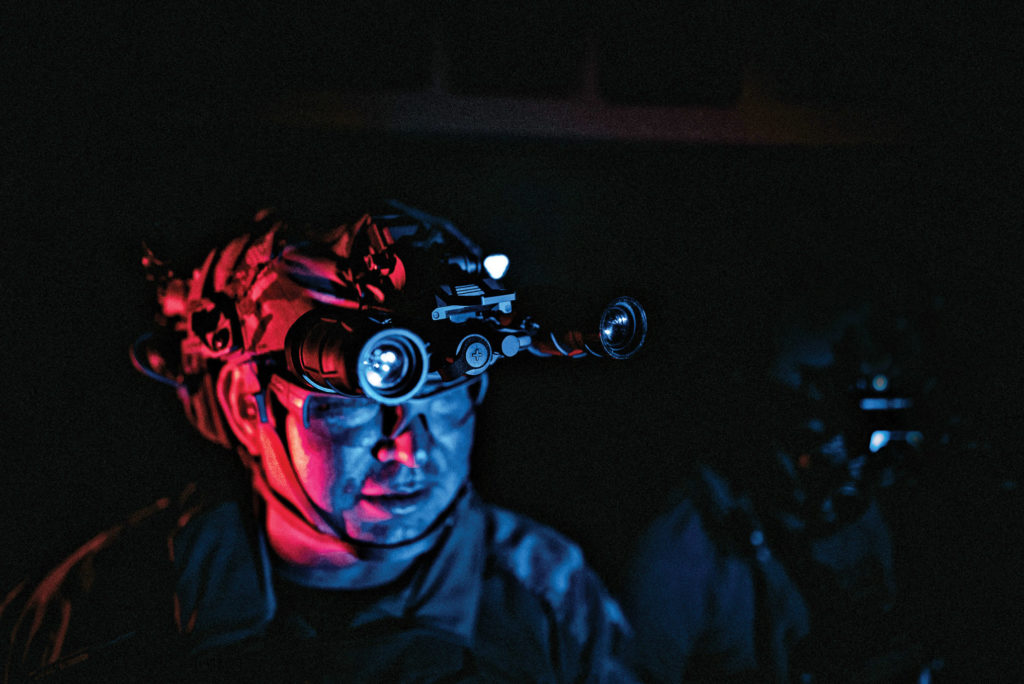
Above: “Being able to see in the dark is a superpower,” says Don. Fortunately, it's a superpower that's becoming more widely available to civilians. – Photo by Real Dirty Media.
Regardless of whether you call them NODs (Night Observation Devices), NVGs (Night Vision Goggles), NVDs (Night Vision Devices), or I2 devices (Image Intensification), we sat down with Don and got the answers to some entry-level questions about what this equipment does and what you should think about before you cross over to the dark side …
RECOIL OFFGRID: Give us a brief overview of how image intensification (I2) works.
DON EDWARDS: Image Intensification tubes amplify existing light, so you have to have some ambient light for them to work at all. They’re specifically optimized to see Infrared (IR) and Near Infrared (NIR) light the best, so even light you cannot see with the naked eye will make them work.
What applications do you see or hear your civilian students using night vision for?
DE: My civilian students who own and use night vision are into all sorts of things. Some just like to go out with buddies and shoot at night. Others are hunters. Night hog hunting is one of the fastest-growing segments of the hunting market. Many are preparedness-minded individuals.
How does night vision fit into your overall security and preparedness plan now that you’re out of uniform?
DE: Being able to see in the dark is like having a superpower. I bring them with me just about everywhere, especially when I travel. In an emergency, I can see potential danger and avoid it. When used along with illumination, even a white flashlight, it can also greatly extend how far you can see in the dark. It also allows me to remain undetected if I want to gather information about the environment prior to choosing a course of action.
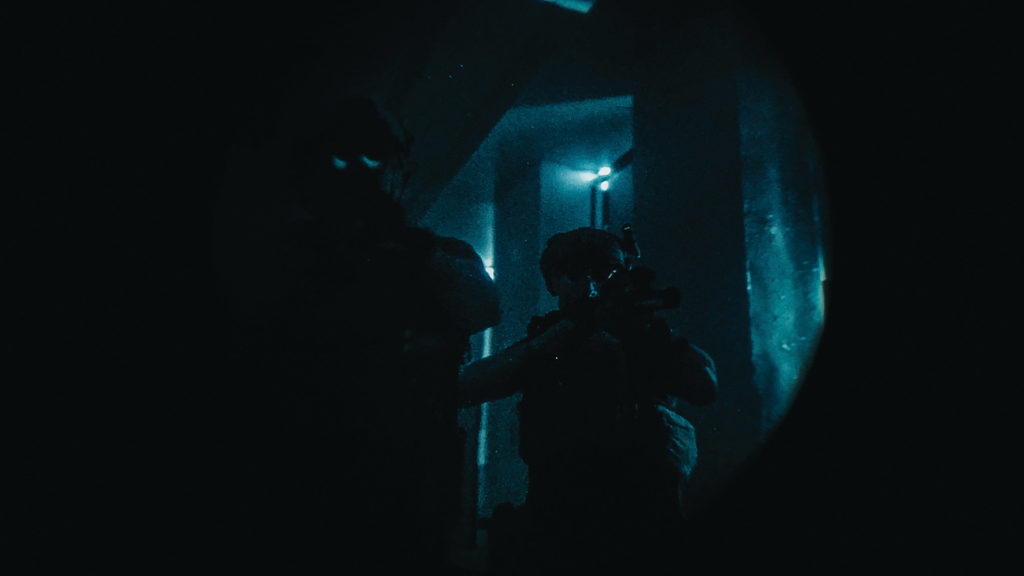
Above: In true no-light environments, an IR illuminator can make a significant difference in your ability to navigate and acquire targets. Photo by Real Dirty Media.
Night vision devices are classified by generation. Most commonly, we see devices labeled “Gen 2” or “Gen 3.” What is the difference?
DE: In the late 1980s, Gen 2 gave way to Gen 3 technology. Since then, all image intensification tubes made in the U.S. are Gen 3. Any current-production Gen 2 devices probably have tubes made in Europe. The primary differences are some of the coatings on the inside that allow better light transmission and amplification. Current U.S.-made Gen 3 will almost always outperform Gen 2 tubes, especially in the lower-light conditions — the darker it gets, the more you’ll notice Gen 3 performing well. There are I2 tube manufacturers in Europe who are manufacturing Gen 2 tubes that rival the performance levels of some Gen 3 devices, but you aren’t going to get that level of performance for the entire life of the device. The Gen 2 will usually begin to degrade sooner and get to unusable levels way before the Gen 3 would.
In what situations would you say Gen 2 (or older) is an acceptable compromise, versus when you might really want a Gen 3 setup?
DE: Gen 2 tubes are still being made, since the U.S. closely guards the Gen 3 technology and restricts exports through ITAR. I’d say it would be fine if you got a great deal on a device that was Gen 2 — otherwise, if you’re buying new, get the best. That would be Gen 3. For some situations when there are lots of lights, like streetlights and such, a good Gen 2 device is preferred by some people.
We see different night vision tubes described as “filmed” or “unfilmed.” What does this mean? Is one better than the other? Or is each better for specific applications?
DE: Unfilmed is a name for I2 tubes manufactured by L3Harris. Technically, we categorize them as being “less filmed.” What I mean by that is they have found proprietary ways of eliminating or reducing the thickness of some of the barriers between the different layers inside the tube. In an optic, the more lenses or protective coatings that light has to pass through, the greater the chance of loss of light. The same is true in I2. Being able to minimize this inside the I2 tube can translate to up to 20 percent or even more increase in performance. Filmed, or thin filmed as they are called, devices are still very capable and continue to get better, but generally the unfilmed tubes will display better performance as it gets darker and darker.
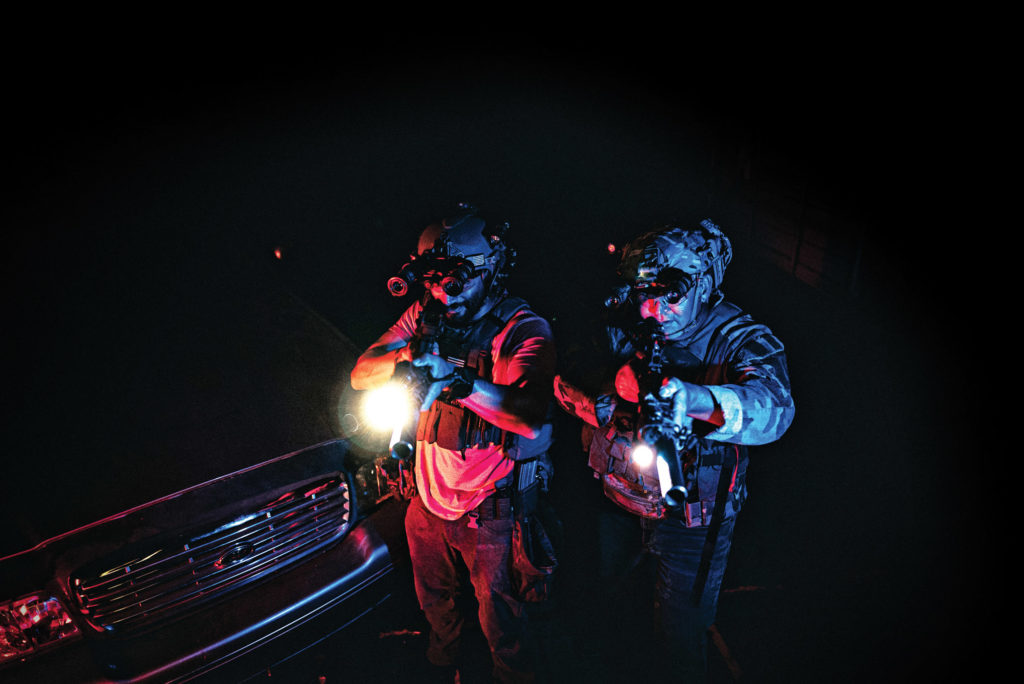

Above: Night vision is one component of overall low-light preparedness, and does not negate or override the need for a high quality white light. Photo by Real Dirty Media.
What is auto-gating? What does it do for end users? Are all NVDs auto-gated?
DE: Auto-gating (AG) is a great feature and has been with us for over 20 years now. Any Gen 3 Night Vision made in the U.S. within the last 20 years will have auto-gating. AG is basically a throttle control that senses when the tube is receiving more light than it needs or can handle, and reduces the amount of power being drawn from the battery. This will cause fewer photons to be energized into electrons, therefore protecting the tube from getting oversaturated and potentially damaged. A side effect of this is that we see increased battery life over the old models because of this.
Let’s talk a little about types of devices themselves. The single-tube PVS-14 is considered by many to be the “entry level” device acceptable for defensive applications. What are some pros and cons to this type of device?
DE: The PVS-14 as of now is still the standard issue NVG to the U.S. Military. That’s gradually changing, but it’s still the workhorse of the Night Vision world in my opinion. I have described it as the Glock 19 or AK-47 of the Night Vision world. Just so dependable, and reliable, and versatile. Some of the pros to it are affordability compared to dual systems, and versatility — it can be head-worn, handheld, can be easily carried in a pouch or day pack, used in conjunction with a camera or smartphone for pictures, and even mounted behind a red-dot optic on a rifle. The only real con is that when wearing it, you are only receiving visual information from one eye.
Should I wear it on my head or mount it on my rifle?
DE: Head mount, hands down. This is the way it was designed: to be head-worn and used with a laser aiming device on a weapon. The main reason for the past popularity of weapon-mounting is that there didn’t used to be civilian-legal options for people to do this. The PVS-14 is rated for recoil up to 5.56, as required by government contracts, but in my experience, it will not survive continuous use like that. Also, it needs to be mounted behind a Night Vision-compatible red-dot optic such as an Aimpoint. The danger in this is the possibility of the red dot burning a permanent spot on the tube over time. Even auto-gating may not prevent this. Wearing on your head allows you to walk around in the dark and move freely. If it’s on the rifle, you have to point the gun at whatever you want to see in the dark.
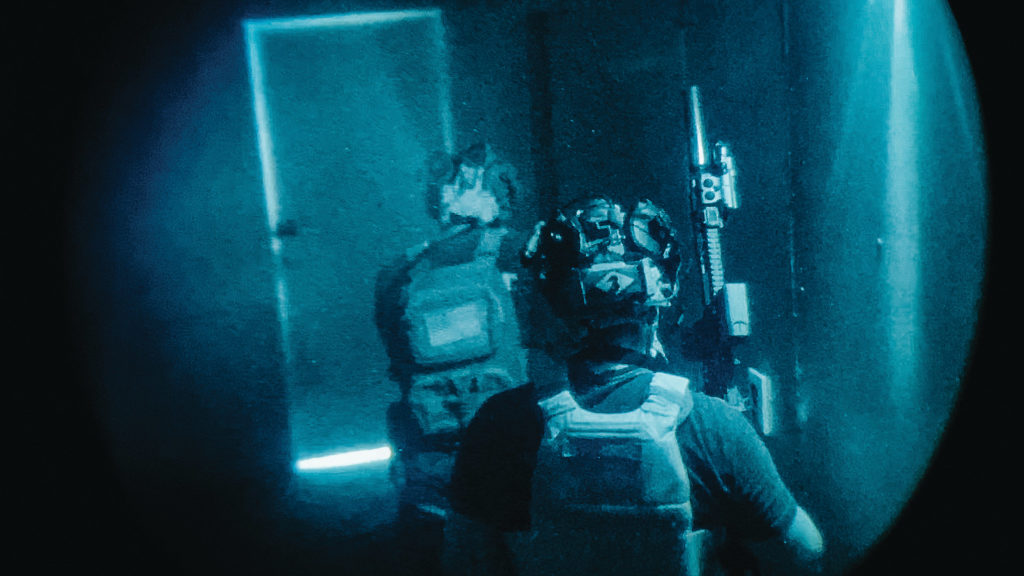
Photo by Real Dirty Media.
If I am wearing it on my person, what would be the benefit to investing in a helmet versus using the stand-alone “skull-crusher” mount?
DE: Many people want to go for the non-helmet-style mounts. There are several companies that make them, and (despite the nickname) they can be quite comfortable. Their usefulness ends, in my opinion, when you start to do more complex stuff. If you are mostly stationary or not engaging in much activity, then they are great. But even walking around the woods at night can cause most of them to flop and wobble around on your head. Most people do not need or want a ballistic helmet — I still recommend one of the affordable, unarmored “bump” helmets. A rigid mounting platform that keeps things where you want them makes a huge difference, and can be had for around $300.
If one tube is good, is two better? What are the advantages of dual-tubes over the PVS-14? Do you get double the field of view?
DE: First, let me address field of view (FoV). Sadly, no, you don’t increase your FoV with duals. By the way, the FoV on monocular and binocular NVGs is 40 degrees. What you get with duals is binocular vision versus monocular vision. Our brains rely heavily on visual input to process information and make decisions. We are used to seeing things with both eyes. Being able to see with both eyes in the dark can exponentially increase your ability to move quickly and accomplish complex tasks. This is why Special Operations people who spend a good portion of their time wearing NVGs prefer binocular NVGs hands down.
If I invest in a dual-tube setup, do I need articulating tubes?
DE: Articulating tubes are a nice feature. I like them, but they’re not a deal breaker. To many, it isn’t that important of a feature. Fixed-bridge-style NVG housings can be slightly more rugged.
What accessories do I need to consider? We’ve heard people talk about counterweights, battery packs, IR flashlights, lasers, magnifier rings, etc. Besides the NVD itself, what else makes a functional, effective night vision system?
DE: Night vision is a system. It helps if you think of it that way. If you have a Night Vision device, you need a way to wear it — let’s say a helmet. You will also need a way to attach it to the helmet, this is called the mount. There are several different models of those out there that provide varying features to the end user. Now, if you are going to be using it along with a rifle, you need to look at some of the various Laser Aiming Modules available to you. These are the key parts of the system.
Counterweights are a plus. If you are wearing a monocular, it may not be that big of a deal. With a dual-tube device, I consider it a must-have. It may seem counter-intuitive at first to add more weight to your head, but putting a counterweight in the back sort of balances out the see-saw on your head. Without it, the goggle is constantly pulling down on the front of your face, and by the end of the night you will have sore neck muscles.
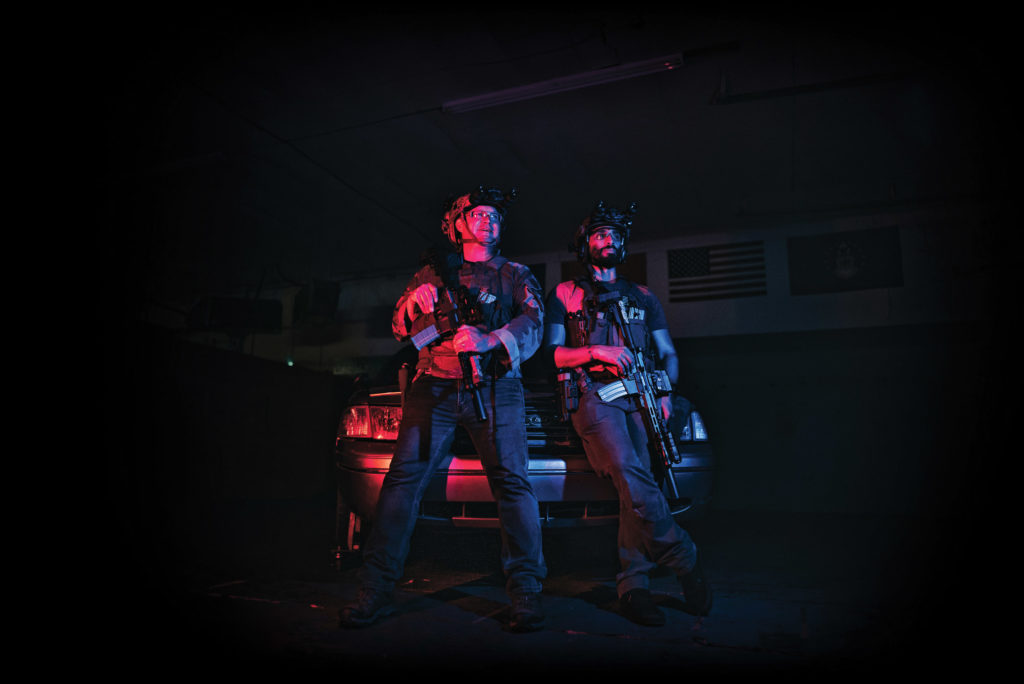
Photo by Real Dirty Media.
Another good idea piece of gear would be a handheld IR light. Not for the weapon, that’s covered by your laser device. A handheld IR light source basically gives you a flashlight that only you (and others wearing Night Vision) can see. That can come in handy in many different situations.
Not everyone can afford top-of-the-line, U.S.-made night vision that’s on-par with military-grade products. Night vision units produced offshore, or assembled in the U.S. with foreign tubes, often lower the cost threshold for entry. What are some of the pitfalls to be aware of when going this route? What are you sacrificing to get that (relative) affordability?
DE: Well, to start with, I try to buy American whenever I can. I hate to say it, but the old saying “buy once, cry once” can’t be truer when it comes to night vision. It’s literally a superpower, and it’s worth saving up for quality equipment that is going to not only last, but will be there for you when you need it the most. A friend of mine has a saying that $1,000 worth of flashlights is better than $1,000 worth of night vision. What he means is that $1,000 worth of Night Vision is probably going to be a waste of money. Also, the cost difference between good quality imported tubes built into devices here in the U.S. is not really much of a discount, so if you’re looking at spending thousands of dollars, save a little more, and make sure you’re getting something quality.
[Editor's Note: This Article First Appeared in OFFGRID #43. Photography by Real Dirty Media]

Don Edwards is a retired 20-plus-year veteran of U.S. Army Special Operations. He began his career in 3rd Battalion 75th Ranger Regiment, where he was a participant in Operation Just Cause. He retired from 20th Special Forces Group, where he served as a team sergeant, weapons sergeant, and intelligence sergeant during combat operations in Iraq and Afghanistan.
He has served for five years as the use-of-force training manager and primary instructor at the ATF National Academy in Glynco, Georgia, instructing in tactics and firearms as well. Don has worked as tactical adviser to the Department of Defense since 2008 serving in both Iraq and Afghanistan, and is a FLETC-certified firearms instructor.
Don is the former director of training for TNVC and is now the owner/operator of Greenline Tactical LLC. Greenline is a leader in night vision operations training, offering real-world tactical and defensive training to law-abiding civilians, state/local law enforcement officers, and SWAT teams as well as conventional and special operations military units around the country.
Sources
Greenline Tactical > www.greenlinetactical.com
 STAY SAFE: Download a Free copy of the OFFGRID Outbreak Issue
STAY SAFE: Download a Free copy of the OFFGRID Outbreak Issue
No Comments